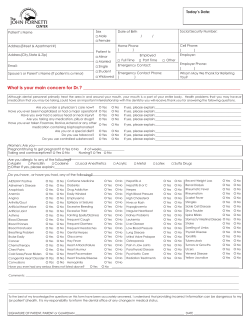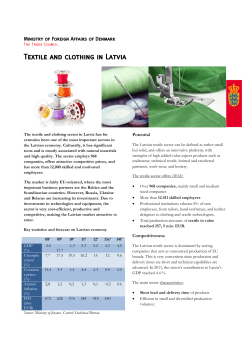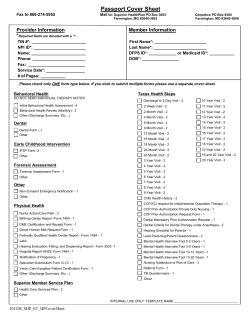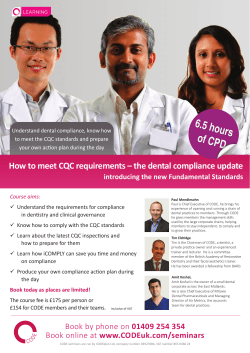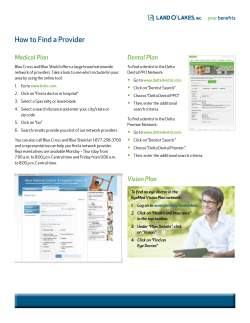
Validation of a Latvian and a Russian version of the... Health Impact Profile for use among adults SCIENTIFIC ARTICLES
SCIENTIFIC ARTICLES Stomatologija, Baltic Dental and Maxillofacial Journal, 16:83-6, 2014 Validation of a Latvian and a Russian version of the Oral Health Impact Profile for use among adults Jolanta Pugaca, Ilga Urtane, Pertti Pirttiniemi, Irena Rogovska Summary Background. The need for appraisal of oral health-related quality of life has been increasingly recognized over the last decades. The aim of this study was to develope a Latvian and a Russian version and test the validity of the Oral Health Impact Profile (OHIP-49) for use among adults in Latvia. Methods. The original English version of the OHIP-49 was translated using the forwardbackward technique, pilot-tested, and then applied to 60 adults aged 18 years and above. The questionnaire was filled out during face-to-face interviews conducted by one specialist. The internal consistency of the questionnaire was evaluated using Cronbach’s alpha (α) coefficient and inter-item and item-total correlations. Discriminant and convergent validities were assessed. Results. Cronbach’s α was estimated to be 0.96. Inter-item correlations coefficients ranged from 0.19 to 0.91, with averige value 0.35, while item-total correlations coefficients from 0.14 to 0.86. Conclusions. The OHIP-49 is a reliable and valid questionnaire for the assessment of OHRQoL among adults in Latvia. Key words: oral health impact profile, validation, OHRQoL. INTRODUCTION Oral health-related quality of life (OHRQoL) is an important patient-centered endpoint to consider when assessing the impact of oral diseases in populations and evaluating the professional interventions used in attempt to improve oral health (1, 2). The Oral Health Impact Profile (OHIP) is a questionnaire designed to measure self-reported dysfunction, discomfort and disability attributed to oral conditions (3) , and is based on a conceptual oral health model outlined by Locker in 1988. The original instrument has 49 items representing 7 domains (functional limitation, physical pain, psychological discomfort, Department of Orthodontics, Institute of Stomatology, Riga Stradins University, Riga, Latvia 2 Departments of Oral Development and Orthodontics and Oral and Maxillofacial Department, Oulu University Hospital, Finland 3 Division of Doctoral Studies, Riga Stradins University, Riga, Latvia 1 Jolanta Pugaca1 – D.D.S., Dr. Med. Ilga Urtane1 – D.D.S., Dr. Med., prof. Pertti Pirttiniemi2 – D.D.S., prof. Irena Rogovska3 – M.D., PhD Address correspondence to Dr. Jolanta Pugaca, Department of Orthodontics, Institute of Stomatology, Riga Stradins University, Riga, Latvia. Dzirciema iela 20, Riga LV- 1007, Riga, Latvia. E-mail address: jolanta.pugaca@gmail.com Stomatologija, Baltic Dental and Maxillofacial Journal, 2014, Vol. 16, No. 3 physical disability, psychological disability, social disability, and handicap) and has been shown to be reliable (4, 5), sensitive to changes and to exhibit suitable cross-cultural consistency (6, 7). The OHIP is available in several languages (German, Swedish, Korean, French, Malaysian, Persian, Sinhalese, Spanish and Chinese), but there are no Latvian and Russian translations available and also no suitable alternative OHRQoL tools developed in Latvia. The aims of this study were to develop Latvian and Russian version of the Oral Health Impact Profile and to evaluate its convergent and discriminative validity, and its internal consistency for use among adult populaton of Latvia. Health-Related Quality of Life (HRQoL) is a multi-dimensional concept, which refers to patients’ physical, psychological and social well-being, and is widely recognised for the assessment of healthcare outcomes. A factor, however, that can significantly impact on the construct of HRQoL is the oral health of the individual. Oral Health-Related Quality of Life (OHRQoL) measures have been widely used in the evaluation of oral health needs and combined with clinical indicators in order to better identify not only patients’ symptoms due to oral diseases 83 J. Pugaca et al. but also patients’ ability to perform their daily activities (7-9). One of the most widely known OHRQoL instruments is the short form of the Oral Health Impact Profile consisting of 14 items (OHIP-14), which is derived from the original 49-item version developed by Slade and Spenser, for the measurement of disability and discomfort due to oral conditions. This instrument has been translated and validated in many languages in different regions of the world. The objective of this study was to translate the original English version of the OHIP-49 into Latvian and Russian, and test its validity and reliability for use among adults in Latvia. METHODS SCIENTIFIC ARTICLES Out of 67 approached individuals, 60 agreed to participate in the study (a response rate of 89 %), all of who provided informed consent. A self-administrated questionnaire was designed and one specialist in OHRQoL terms conducted face-to-face interviews. Participants were asked to evaluate on a 5- point Likert scale (0=never, 1=hardly ever, 2=occasionally, 3=fairly often and 4=very often) how frequently during the last year had experienced any of the problems assessed by the 49-item OHIP. Scoring Method and Data Analysis Statistical analysis was performed using the Statistical Package for Social Sciences (SPSS) v.19. To assess the reliability of the OHIP-49, Cronbach’s α coefficient was used. In addition, the impact on the alpha value by the removal of OHIP-49 items (alpha if item deleted) was evaluated, as well as inter-item and item-rest correlations. A Latvian and Russian version of the OHIP- 49 was developed and its psychometric properties were tested in 2 stages: 1) a linguistic translation of the original OHIP-49 into Latvian and Russian and 2) to evaluate the construct’s validity. For the OHIP-49 to be translated, four independRESULTS ent translations were conducted: two forward and two backward translations. Following comparison The comparison between the original OHIP of these two forward translations, to ensure the best questionnaire and the back translated English verinterpretation of the original version, the prelimision did not reveal conceptual content differences. nary Latvian and Russian version of the OHIP-49 The participation rate was acceptable (89%) . The was generated. Afterwards, two independent bilinmean age in study group was 33.5 years (Table 1). gual individuals unfamiliar with the original version, whose first language Table 1. Mean age of the study groups was English, were asked to conduct Questionary language Latvian the backward translations compared n Mean age Std. Dev. Max age Min age to the original English version to 30 32.87 13.32 60 19 check the similarity of their strucQuestionary language Russian ture. The final version of the Latvian Mean age Std. Dev. Max age Min age and Russian OHIP-49 was produced n 30 36.2 12.42 68 20 after minor modifications were made according the results of a pilot study. The participants consisted of a con- Table 2. Mean age comparison between Latvian and Russian groups venience sample of 60 adult patients Group n Mean Std. error Std. deviation 95% Conf. Interval undergoing a dental and orthodontic Lv 30 32.87 2.43 13.32 27.89 37.84 check-up or accompanying parents in Ru 30 36.20 2.27 12.42 31.56 40.83 the Institute of Stomatology. This was Combined 60 34.53 1.66 12.88 31.20 37.86 selected based on the availability of Diff. -3.33 3.32 -9.99 3.32 an appropriate middle-age group of the population in one place. Table 3. Gender diferences of the sudy group Those presenting with acute denGender Language Total tal problems were excluded. All subjects were acquainted with L/n R/n the purpose of the study, which was M 9 (30%) 9 (30%) 18 ethically approved by the Research F 21 (70%) 21 (70%) 42 Committee of the Riga Sradiņš UniTotal 30 30 60 (100%) versity. 84 Stomatologija, Baltic Dental and Maxillofacial Journal, 2014, Vol. 16, No. 3 SCIENTIFIC ARTICLES Mean age diferences were not statistically significant. There were no diferences between different ages in understanding OHIP questions (Table 2). The gender diferences for both Latvian and Russian groups showed female prevelenece – 70% of all paticipants (Table 3). Reliability analysis was caried out based on the OHIP inter-item correlation for Latvian and Russian groups. Internal consistency was calculated for OHIP for Latvian group (Table 4). Cronbah’s alfa coeficient was 0.96. Interitem correlation average value 0.35 for each of 7 dimensions and for all together. Internal consistency for OHIP for Russian group (Table 5). Cronbah’s alfa coeficient was 0.97. Interitem correlation average value 0.44 for each of 7 dimensions and for all together. J. Pugaca et al. Reliability The Cronbach’s alpha value of the OHIP-49 was estimated to be 0.96 for latvian group and 0.97 for Russian, representing an excellent internal consistency. The removal of one item at a time resulted in lower alpha values than the original one, supporting the inclusion of all items. By analyzing the matrix of inter-item correlations a positive correlation between all items was found. DISCUSSION This study aimed to generate and evaluate the Latvian and Russian version of the OHIP-49, in terms of validity and reliability, for use among adult population. To this effect, the original English version of the OHIP-49 was translated using the forward-backward technique, pilot-tested in a conveniTable 4. Internal consistency for OHIP for Latvian group, n=30 ence group of adults and then applied to a sample of the Latvian populaInternal consistency for OHIP – and its 7 domains tion having approximately the same Dimensions Item-test Item-rest Averige Cronbach’s socio-demographic and oral health correlation correlation inter-item α conditions, in order for its validity and correlation reliability to be tested. The translation Functional 0.46 0.37 0.35 0.96 process from English to Latvian and limitation Russian was straightforward and the Physical pain 0.41 0.38 0.35 0.96 comparison between the original OHIP Psychological 0.83 0.81 0.34 0.96 questionnaire and the back translated discomfort English version did not reveal concepPhysical 0.55 0.53 0.35 0.96 tual content differences. disability The findings of our study, which Psychological 0.82 0.81 0.34 0.96 is the first using the OHIP-49 in Latvia disability confirm that the OHIP-49 is a reliable Social 0.54 0.53 0.35 0.96 and valid instrument for the measuredisability ment of OHRQoL among adults in Handicap 0.78 0.77 0.43 0.96 Latvia. The internal consistency of the Table 5. Internal consistency for OHIP for Russian group, n=30 Latvian and Russian OHIP-49 (0.96 Internal consistency for OHIP – and its 7 domains and 0.97) was found to be excellent, Dimensions Item-test Item-rest Averige Cronbach’s with the Cronbach’s alpha coefficient correlation correlation inter-item α greatly exceeding the minimum reccorrelation ommended value of 0.7. Functional 0.49 0.46 0.44 0.97 The Cronbach’s alpha coefficient limitation reported in our study was slightly Physical pain 0.58 0.56 0.44 0.97 better than those reported by Slade Psychological 0.68 0.64 in the original English version, but 0.44 0.97 discomfort the same with that found for Swedish Physical 0.71 0.61 adults (10) and Dutch population (11). 0.44 0.97 disability The substantial internal consistency of Psychological 0.78 0.77 the instrument was also supported by 0.44 0.97 disability the findings regarding inter-item and Social 0.79 0.78 item-total correlations. Specifically, 0.44 0.97 disability all the inter-item correlations were Handicap 0.81 0.78 0.44 0.97 positive, and none was high enough Stomatologija, Baltic Dental and Maxillofacial Journal, 2014, Vol. 16, No. 3 85 J. Pugaca et al. for any item to be redundant, while the item-total correlations coefficients were above the recommended threshold for including an item in a scale. Similar results have been observed in the Spanish (12) and the Sinhalese version (13) of the OHIP14, both evaluating the reliability of the instrument among adults. The mean score values in this study suggest a relatively low impact of oral health in the population studied, similar to the impact reported among Myanmar adolescents (14) with low levels of dental disease and considerably lower than the SCIENTIFIC ARTICLES medicaly compromised elderly people (5) and than the oral health impact reported in studies comprising minority adolescent populations with higher oral disease burden and adult populations (15-18). CONCLUSIONS The present findings indicate that the OHIP-49 proved to be a valid and reliable measure to be used in studies focusing on the measurement of adults’ OHRQoL in Latvian adults. REFERENCES 1. Tonetti MS. Periodontitis and risk for atherosclerosis: an update on interventional trials. J Clin Periodontol 2009;36(Suppl.10):15-9. 2. Wimmer G, Pihlstrom BL. A critical assessment of adverse pregnancy outcome and periodontal disease. J Clin Periodontol 2008;35(Suppl.8):380-97. 3. Petersen PE. The world Oral Health report: continuous improvement of oral health in the 21 st century - the approach of WHO Global Oral Health Programme. Community Dent Oral Epidemiol 2003;31(Suppl.1):3-23. 4. Globiene J. Prevalence of gingivitis and periodontitis among Lithuanian rural population aged 25-64. Stomatologija 2001;2:14-6. 5. Schüz B, Wiedemann AU, Mallach N, Scholz U. Effects of a short behavioural intervention for dental flossing: randomized-controlled trial on planning when, where and how. J Clin Periodontol 2009;36:498-505. 6. Öhrn K, Sanz M. Prevention and therapeutic approaches to gingival inflammation. J Clin Periodontol 2009:36(Suppl.10):20-6. 7. Kawamura M. Dental behavioral science. The relationship between perceptions of oral health and oral status in adults. J Hiroshima Univ Dent Soc 1988;20:273-86. (In Japanese). 8. Kawamura M, Honkala E, Widström E, Komabayashi. Cross-cultural differences of self-reported oral health behavior in Japanese and Finnish dental students. Int Dent J 2000;50:46-50. 9. Kawamura M, Iwamoto Y, Wright FAC. A comparison of self-reported dental health attitudes and behavior between selected Japanese and Australian students. J Dent Educ 1997;61:354-60. 10.Komabayashi T, Kwan SY, Hu DY, Kajiwara K, Sasahara H, Kawamura M. A comparative study of oral health attitudes and behavior using the Hiroshima University Dental Behavioural Inventory (HU-DBI) between dental students in Britain and China. J Oral Sci 2005;47:1-7. 11.Peker K, Uysal Ö, Bermek G. Dental training and changes in oral health attitudes and behaviors in Istanbul dental students. J Dent Educ 2010;74:2017-3023. 12.Neeraja R, Kayalvizhi G, Sangeetha P. Oral health attitudes and behavior among a group of dental students in Bangalore, India. Eur J Dent 2011;5:163-7. 13.Al-Wahadni AM, Al-Omiri MK, Kawamura M. Differences in self reported oral health behavior between dental students and dental technology/dental hygiene students in Jordan. J Oral Sci 2004;46:191-7. 14.Polychronopoulou A, Kawamura M. Oral self-care behaviours: comparing Greek and Japanese dental students. Eur J Dent Educ 2005;9:164-70. 15.Komabayashi T, Kawamura M, Kim KJ, Wright FA, Derleck D, Goiâs Mdo C, et al. The hierarchical cluster analysis of oral health attitudes and behaviour usig Hiroshima university-Dental Behavioural Inventory (HU-DBI) among final year dental students in 17 countries. Int Dent J 2006;56:310-6. 16.Yildiz S, Dogan B. Self reported dental health attitudes and behaviour of dental students in Turkey. Eur J Dent 2011;5:253-9. 17. Buchwald S, Kocher T, Biffar R, Harb A, Holtfreter B, Meisel P. Tooth loss and periodontitis by socio-economic status and inflammation in a longitudinal population-based study. J Clin Periodontol 2013;40:203-11. 18.GTSS collaborative group. Tobacco use and cessation counselling: global health professionals survey pilot study, 10 countries, 2005. Tob Control 2006;15(Suppl.2):31-4. Received: 09 01 2014 Accepted for publishing: 26 09 2014 86 Stomatologija, Baltic Dental and Maxillofacial Journal, 2014, Vol. 16, No. 3
© Copyright 2025


